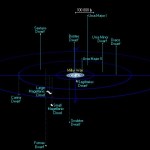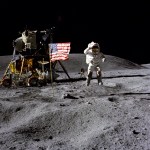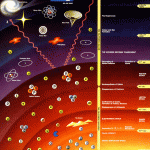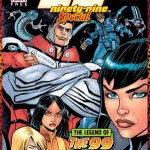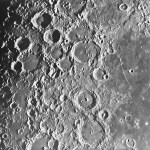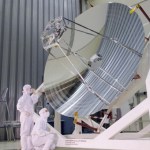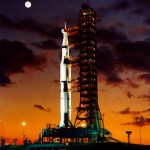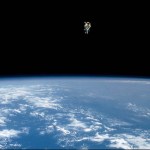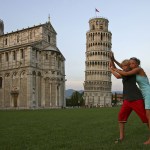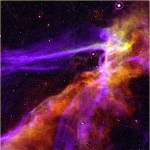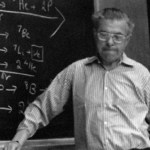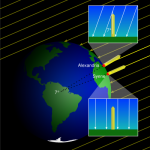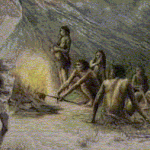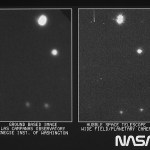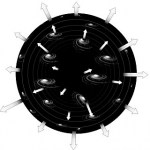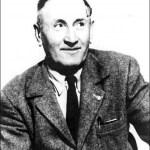
By the 1980s, our view of the Universe was pretty close to what it is today. We had confirmed the Big Bang Theory and even had some understanding of what must've caused the Big Bang. There were some mysteries around, such as dark matter, the age of the Universe, and the solar neutrino problem, but all in all, we were on pretty solid ground.
One of the things astronomers had been waiting for was a supernova to go off in our galaxy. We expect about one per century in our galaxy, and we hadn't seen one since 1604! It's 2009 now, and we still haven't seen one, but in 1987, we got closer than any…
Okay, so you've seen the famous photos from the Apollo Moon landings:
And you've been around the block enough to know why we really landed on the Moon. But let's say you wanted, for some reason, to stage your own fake jaunt on the Moon.
The band Rammstein did an excellent job with the first 30 seconds of their video, Amerika:
So how do you do it? Well, first off, you need some nice, Moon-colored dirt. You've got two options here. One is to go someplace where you can see something like Craters of the Moon national monument in Idaho. After all, this will do nicely for an area to film:
But…
We have come so far in the last 100 years, and so has our picture of the Universe. From an island galaxy ruled by Newton's gravity and classical electromagnetism, we've come through the discovery of general relativity, the expanding Universe, the need for dark matter, the big bang, the synthesis of all the elements in the Universe, and, for good measure, we walked on the Moon. By the 1970s, we had a fabulous picture of the History of the Universe.
There's just one (huge) problem: What caused the Big Bang? We know the laws of gravity and quantum mechanics, and we know that the Universe is…
I've only recently become musically acquainted with the artist Slaid Cleaves, born in Maine and living in Texas. This weekend, I present to you a heartbreaking song, Lydia, about a kind, wise old woman who can't quite pull her life together after the death of her son.
Oh, Lydie, let him go. The boy is gone.
Her mother struggled as she tore him from her arms.
Oh, Lydia, your tears are heaven's rain.
But she never was the same.
He hasn't hit it big yet, but his music is good enough that I think he ought to. Listen for yourself:
But there's something else -- that's also wonderful -- that is…
Earlier this week, the most obvious scientific news in recent memory was reported: there's Uranium on the Moon.
This has been, pretty much, a slam-dunk since Apollo 11. Why? Because we've brought moonrocks back to Earth, and we've analyzed them thoroughly. What did we find? That they're made of the same stuff that Earth-rocks are made of!
I mean, not that that isn't interesting. None of the other rocky bodies in our Solar System have the same composition as Earth, which helped lead us to the understanding that the Moon was made out of the same stuff that made Earth. In fact, one of the…
Just a few weeks ago, the Herschel Telescope was launched into space and successfully deployed. Herschel is larger than the Hubble Space Telescope, but instead of measuring visible light, it measures far-infrared light.
This means that, when you look at any object in the Universe, the Hubble Space Telescope sees (mostly) visible light, or light between 400 and 700 nanometers. What gives off visible light? Stars, mostly, as well as some types of heated gas and dust. On the other hand, the light that Herschel sees is much cooler, between 55,000 and 672,000 nanometers.
Longer wavelengths mean…
There's no doubt that physics and astronomy was booming in the 1960s. The model that protons and neutrons were made of quarks was proposed and validated, the most powerful nuclear device of all time was detonated, and the Cosmic Microwave Background was discovered, validating the Big Bang. (Not to mention devastating advances in biology, too.)
But something far more awesome than that happened in 1969.
It not only trumps splitting the proton and confirming the Big Bang, it is -- for me -- the finest accomplishment in all of human history. And its 40th anniversary is exactly three weeks from…
Last week, I was lucky enough to get to host the Carnival of Space. This week, the honor goes to Jennifer Ouellette at Twisted Physics, and my article on the 1950s and Fred Hoyle gets top billing! There are a bunch of other highlights to check out. Here are my top 3 CoS picks of the week:
1. Ever what would have happened in the 1960s if the Apollo program had failed? Beyond Apollo takes an in-depth look at a secret backup plan from the RAND corporation that was NASA's number 2 option.
2. All planets that can support life may have their possibly habitable lifetimes greatly extended once life…
The Earth is one of those extremely rare, special places in the Universe where water can exist, stably, as a liquid. So much of it exists here on Earth, that if you were to add up all the oceans on Earth together, it would weigh more than 10^18 tonnes, more massive than the biggest asteroid ever, and about as massive as Pluto's giant moon, Charon.
But water only has a very small window in which it can be a liquid. For instance, if you took some warm water up to a very high elevation, it would start to boil, and become a gas! The higher up you took it, the lower and lower your boiling point…
All the day long whether rain or shine
she's a part of the assembly line
she's making history working for victory
Rosie the Riveter!
One of the most iconic images, spawned by this song:
is that of Rosie the Riveter. For the first time in the United States, women were not only entering the workforce, they were doing men's work, and doing it completely, competently, and basically driving the production of the American manufacturing industry.
This started in around 1939/1940, when American resources were starting to get sucked into World War II, and was in full swing by 1943. I had seen some…
Or, to put it as one of my readers/questioners did,
Why doesn't the Space Needle, a top-heavy skyscraper, ever tip over and fall?
This is reasonable, and there's precedent for this. After all, the Leaning Tower of Pisa was falling over, and needed significant foundation-work just to keep it upright.
Now, when you take something like the Space Needle, it looks like most of the weight is in the top:
And it looks even more significant if you stand at the bottom and look up:
Yet, in actuality, the Space Needle is one of the most stable structures ever, and will be one of the last buildings…
Earlier this week, I wrote about how the heavier elements in the Universe were made. Specifically, that they are made in stars. These stars then explode in a variety of ways, enriching the Universe with these heavy elements, and allowing us to form glorious things, like our planet!
By contrast, the big bang makes light elements, but not heavy ones. Why is this the case, and how do we know? Let's find out.
Image credit: Stephen Van Vuuren, created from a simulation of 80,000 star images.
Just a few seconds after the big bang, the Universe is filled with protons and neutrons, in roughly the…
There is a long history of oppression of women on many fronts in our society. Socially, politically, economically, and legally, among others. There are a number of very good bloggers here who often address gender issues, and I'm not typically one of them.
But two things happened to me yesterday that brings up a gender issue that nobody speaks about: a man's rights in an unplanned pregnancy. I reconnected with an old friend on facebook who had knocked up his (much younger) girlfriend a few years ago, and didn't want a kid. She wanted to keep it, putting him in a catch-22. Either he could…
In the 1940s, the Big Bang theory was first conceived and detailed. But, to quote Niels Bohr,
We are all agreed that your theory is crazy. The question which divides us is whether it is crazy enough to have a chance of being correct. My own feeling is that it is not crazy enough.
One of the staunchest opponents of the Big Bang idea was Fred Hoyle, an outstanding, prolific scientist in his own right.
In the 1950s, Fred Hoyle found it inconceivable that all of the heavy elements in the Universe -- practically everything we find on Earth -- would have been made in the Universe's infancy. He…
We have a treat for you this week: Starts With A Bang gets to host this week's Carnival of Space! We take the best space and astronomy posts from around the internet and pull them together in one great extravaganza! I've gotten to host twice before, and this is a very special edition for astronomers. Why, you ask?
Yesterday was the Summer Solstice! Longest day of the year (for us Northern Hemisphere folk), most sunlight, the Sun gets highest in the sky, and shadows are the shortest. If you want to go all the way back, this was the day that allowed us to discover the Earth was round! Let's…
Somewhere in my mind, I like to try and construct a timeline of all of human history. Yes, there's the obvious stuff, like the discovery of fire, the learning of what foods will and won't kill you, the domestication of the dog, and all the similar things that led us to become successful hunter/gatherer tribes. Yes, these were incredibly important steps, which allowed us to do things like eat more meat without getting sick through the power of cooking, find out that some poisonous plants are actually edible when you either boil them or eat only the proper part (hi, rhubarb), and the start of…
First light is one of the most important tests of any new telescope. It allows you to look at a well-known object, see if there are any problems with your telescope, and to get a small glimpse of how good your telescope is going to be.
Almost 20 years ago, we launched the Hubble Space Telescope. For its first light image, astronomers zoomed in on an area of the cluster NGC 3532, an open star cluster known as the Wishing Well Cluster:
(For all images in this post, you can click on them for a hi-res version.) From this one image, we were not only able to obtain incredible resolution on the…
By 1948, our view of the Universe had changed drastically from 1909. Instead of space being run by Newton's Gravity, where our Milky Way comprised the entire Universe, we had learned that space and time are governed by Einstein's General Relativity, that our Universe contained at least many thousands of other galaxies, and that the farther these galaxies were from us, the faster they moved away from us. In other words, the Universe was not only vast and full of interesting stuff, it was also expanding as it got older!
The prevailing idea of the day was the Perfect Cosmological Principle,…
There are many great discoveries that happened in the 1930s that changed our view of the Universe. From tiny discoveries (the neutron) to huge ones (Pluto), from theoretical explanations of antimatter to the neutrino to the start of quantum field theory, the 1930s were a great time for making new discoveries. But one man often gets left out of these discussions, IMO, because he was too far ahead of his time.
Meet Fritz Zwicky. Born in Bulgaria, a citizen of Switzerland, and did his best work at Caltech. (In fact, his daughter Barberina has noticed my old site!) Fritz was in the very tough…
We've got a lot going on here in America these days, with towering unemployment, a dying manufacturing industry, huge environmental problems, and the tense fight for all sorts of rights and freedoms, such as GLBT equality and abortion rights. But there are two things that I'd like to remind you of this weekend. First off, not only are there other places far worse off then America, but we really have no idea what's even going on there. As Manu Chao sings below (in Arabic), people don't know (or even care) about what's going on in Algeria (English lyrics here).
But the song -- Denia -- is both…
